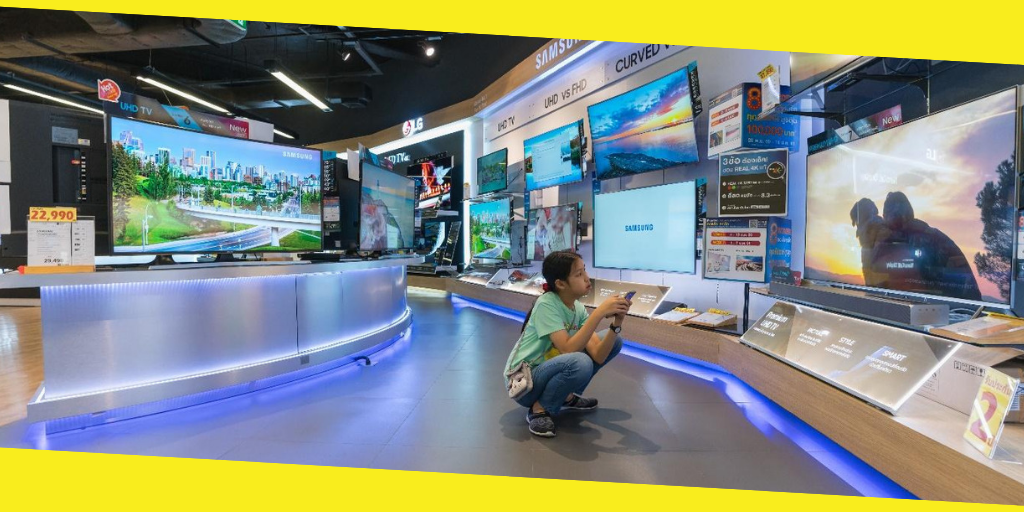How to Buy the Best TV
This post was last updated on December 18th, 2024

The television industry has evolved rapidly in the last few decades from CRT (Cathode-Ray Tube) to LCD (Liquid-Crystal Display) and more. It is a booming industry and the types of TV on the market now from major manufacturers come with a bunch of features and accessibility options. They are known as smart TVs and come with high definition displays which are leading the market right now.
Different Sizes of TVs
Today, people are inclined to buy TVs with bigger screens, more features, and reduced bezels. TVs come in different sizes and are getting bigger every day using more advanced technology. The TV screen size is directly dependent on the distance you watch it from and the size of the wall you plan to mount it on.
TVs that are 32-inches and below cost significantly less and are available from most major manufacturers. TV’s less than 32 inches are not currently capable of accommodating the required number of pixels for a 4K display. They come as smart TVs and provide access to the internet and other entertainment sources.
The next range of TVs comes between 40 and 43 inches of diagonal length and are sold in large numbers across the globe. Along with smart features they also support the 4K display and are favored hugely by the customers due to affordable costs and high picture quality.
TVs in the 49-55 inch range need special manufacturing equipment and adherence to stringent protocols for creating the perfect high definition product. Market leaders invest profusely in this range of size for the 4K and HDR display features. A huge number of different TVs are manufactured in this range and some are more affordable with fewer features.The high-end TVs currently on the market exist in the range of 55 inches and above and include the latest features. They can also come in curved display options that enhance the viewing experience along with 4K resolution and smart features.
How to Decide the Budget for Your New TV?
LCD televisions are very affordable products these days and a decent medium-sized TV normally costs something around $300 which is quite affordable for a long-investment. Going a little up to $400 can fetch you a TV in the 40-43 inch range that comes with Full HD or even Ultra 4K resolution and smart functionalities.
According to the stats, the average investment made by families and individuals on TVs is close to $750. Going up to $800 can fetch TVs with significant additional features and sturdy designs as well as a reduced bezel size. High-end TVs can offer high refresh rates above the global standard of 60Hz for enhanced motion processing. Cheaper TVs do not have the capability to perform at even refresh rate of 60Hz often resulting in lags during display of detailed environments.
Classification of Display Technologies
The major breakthrough in the TV technology was the introduction of LCD TVs and it took over the market of CRT TVs which are obsolete now. LCD (Liquid Crystal-Display) as the name suggests involves a thin layer of liquid crystals spread across the lengths and widths of the screen uniformly. A backlight behind the LCD layer lights up the crystals according to the electrical signal received forming the desired images. An LCD TV comes at a very cheap price and is easily affordable.
Organic LED or OLED technology has significantly improved contrast and motion processing. OLED TVs can cost thousands of pounds and start from at least $1,000. OLEDs have taken over the LCD market and are considered as one of the premium quality TVs that function brilliantly using Light Emitting Diodes. Unlike LCD, it does not have a backlight but has LEDs directly on the screen offering amazing picture quality.
The recent technological advancements gave rise to QLED screens which is quite different from OLEDs. QLEDs lights up quantum dot to form pictures that offer brilliant contrast and detailing and guarantees longevity. This technology is available on larger screens and costs good money.
A Comparison Between 4K UHD and HD
With the prices of 4K TVs coming down, it only makes sense to buy 4K now rather than a basic HD or FHD TV. Though the global transition to 4K is a slow process and will take years to be at every place around the globe, research shows that 4K TVs offer a far better picture than HD sets.
The sales of 4K sets count to a major chunk of the total sales from the major brands around the world. The difference in 4K and HD is the number of pixels which is 4 times more than FHD, facilitating much higher resolution and detailed pictures.
Choosing the Perfect Brand
The TV industry is a huge market worth billions of dollars and global brands are famous in every corner of the world. Some of the market leaders include LG, Samsung, Panasonic and Sony.
Currently, Samsung is leading the race to the top with LG lagging just behind. They offer a variety of TVs embedded with state-of-the-art technology in various sizes. The market trend is moving towards larger screen sizes and TVs above 50 inches are always available on the market with options of free and safe delivery from some brands.
Other brands like Philips and Toshiba have lost a significant market share in recent years and are not the preferred choice of brands in the world currently.
HDR or High Dynamic Range
The HDR technology significantly improves the luminosity and the color density to create jaw-dropping pictures that are a delight to watch. 4K television sets support the HDR feature but at present, there is a shortage of HDR content in the market which is a must to observe the effect of this feature.
HDR has different versions such as HDR10 and HDR10+ with HDR10 used majorly in the current 4K TV sets. Costly TVs from Sony and LG come with the HDR10+ feature which is by far the latest technological breakthrough in the industry.
The Story of Curved TVs
About 10 years ago, the world came across a newly designed TV that has a smooth curve throughout the body and started selling at a very steep price. The hype faded out in later years and the prices dropped tremendously. Currently, the major brand Samsung is the sole seller of curved TVs in the market. The creators believed that the curvature improves the picture reception and emulates a 3D effect on a big screen.
This was proven wrong through research as the effect would be only observable while sitting straight and very close to the TV which is not recommended at all. Before buying one, you should have a good understanding of your requirements and whether the wrapping effect due to the curvature is really necessary to you.
The Season for Discounts
A simple analysis proves that the prices are slashed during the month of June every year. There are small windows during November when the prices fluctuate abnormally and can dip very low if you are lucky to snap up a black Friday bargain. Research has found out that after 8 months of launch any TV will reach its lowest price point. It is important to check reviews and the demand of the TV in the market for the best buy. 10mango have done a great analysis of the top 10 4K TVs in this article and it serves as a great buyers guide.
Every year new TV upgrades are released that offer better functionality and picture quality using cutting-edge technology along with a strong metal design for protection against potential damage. Buying a TV is a big decision sometimes, and it is a must to do some personal research and inquire on specs before striking the deal.
Recommended For You
Top Internet Service Locators to Find an ISP in Your Area
Most Inside
Most Inside offers high-quality recommendations and valuable updates to enhance all aspects of your life, providing premium guidance and enriching experiences.




